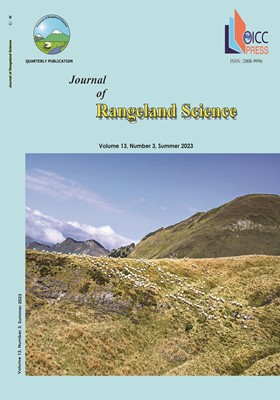Economic Value of Morocco Oued Beht Watershed Rangeland Habitats in terms of Forage Production
محورهای موضوعی : Analysis and EvaluationIsmaili Hassana 1 , Elasri Bouchra 2 , Ghazi Souad 3 , Ziri Rabea 4 , Brhadda Najiba 5
1 - Plant, Animal, and Agro-industry Production Laboratory, Faculty of Sciences, Ibn Tofail University, BP.133, University Campus, Kenitra 14 000, Morocco
2 - Plant, Animal, and Agro-industry Production Laboratory, Faculty of Sciences, Ibn Tofail University, BP.133, University Campus, Kenitra 14 000, Morocco
3 - Plant, Animal, and Agro-industry Production Laboratory, Faculty of Sciences, Ibn Tofail University, BP.133, University Campus, Kenitra 14 000, Morocco
4 - Plant, Animal, and Agro-industry Production Laboratory, Faculty of Sciences, Ibn Tofail University, BP.133, University Campus, Kenitra 14 000, Morocco
5 - Plant, Animal, and Agro-industry Production Laboratory, Faculty of Sciences, Ibn Tofail University, BP.133, University Campus, Kenitra 14 000, Morocco
کلید واژه: Rangeland, Economic value, Overgrazing, Sustainable Management,
چکیده مقاله :
Rangelands represent a potential resource with a high socio-economic value. This value remains unmonetarized and therefore, not taken into account in public policies, which does not reflect the real value of this Ecosystem Services (ES) and negatively affects the sustainable management of rangelands. This study was carried out in 2019; it aims to estimate the economic value of the supply service of the rangelands and to demonstrate its place in the local economy. The result reflects the socio-economic importance of this service, offering an average of 22.65 million forage units (FU/year= 1 kg barely grain), with the gross economic value of 6.79 million USD/year. The study also illustrates the degree of pressure on these pastoral ecosystems, represented by high overgrazing rates and negative net economic value. The comparison between the supply and demand of forage units shows an average cost of degradation of 760 USD /ha in forests and 209 USD/ha out of forests, which negatively affects the sustainable management of these resources. To this end, the strategies adopted must respond to all environmental and socio-economic challenges, based on the preservation of the fragile environment to benefit the socio-economic development of local populations. These strategies must give users a sense of responsibility in the process of setting up, monitoring, and eventually adapting the management systems practiced.


